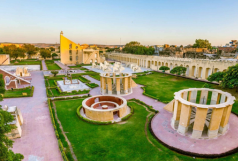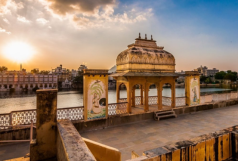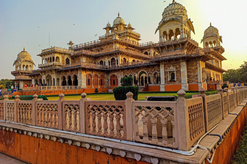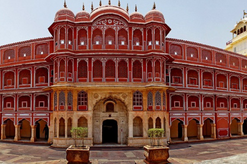Must Visit Forts of Rajasthan
Rajasthan, known as the Land of Kings, is famous for its magnificent forts and palaces that stand as a testament to its royal past. These forts not only represent the architectural grandeur of a bygone era but also tell stories of valor, sacrifice, and a rich cultural heritage. Each fort in Rajasthan has its own unique charm, making it a must-visit destination for tourists. In this blog, we will take you through some of the must-visit forts of Rajasthan, giving you a glimpse of the state's royal history and its architectural brilliance.
Amber Fort, Jaipur
The Amber Fort, also known as Amer Fort, is one of the most popular tourist attractions in Rajasthan. Located just outside Jaipur, this fort is a fine example of Rajput and Mughal architecture. Built in the 16th century by Raja Man Singh I, the fort is known for its artistic style and intricate carvings. Inside the fort, visitors can explore the Sheesh Mahal (Palace of Mirrors), the Diwan-e-Aam (Hall of Public Audience), and the Sukh Niwas, where cooling water cascades down the walls. A visit to Amber Fort is incomplete without experiencing the elephant ride up the hill or witnessing the light and sound show in the evening.
Mehrangarh Fort, Jodhpur
Overlooking the Blue City of Jodhpur, Mehrangarh Fort is one of the largest and most well-preserved forts in India. Built in 1459 by Rao Jodha, the fort stands at 400 feet above the city and is surrounded by thick walls. Mehrangarh Fort is known for its grand palaces, including the Moti Mahal (Pearl Palace) and the Phool Mahal (Flower Palace), which display the richness of Rajput architecture. The fort also houses a museum that showcases a collection of artifacts, weapons, and royal belongings. The stunning views of Jodhpur from the top of the fort are a sight to behold.
Jaisalmer Fort, Jaisalmer
Jaisalmer Fort, also known as Sonar Quila (Golden Fort), is a UNESCO World Heritage site and one of the few "living forts" in the world, with nearly one-fourth of the old city's population still residing within its walls. Built in 1156 AD by the Bhati Rajput ruler Rao Jaisal, the fort stands tall in the middle of the Thar Desert, its yellow sandstone structure glowing in the sun, giving it a golden appearance. Inside the fort, you'll find a maze of narrow alleys, temples, palaces, and residential buildings. Jaisalmer Fort is a true gem for history buffs and architecture lovers.
Chittorgarh Fort, Chittorgarh
Chittorgarh Fort is the largest fort in India and a symbol of Rajput bravery and sacrifice. The fort, built in the 7th century by Mauryan rulers, has witnessed numerous battles and is remembered for the legendary tales of Queen Padmini and her act of Jauhar (self-immolation) to protect her honor. The fort complex includes various structures such as the Vijay Stambh (Tower of Victory), Kirti Stambh (Tower of Fame), palaces, temples, and reservoirs. The grandeur of Chittorgarh Fort and its historical significance make it a must-visit for those interested in Rajasthan's royal heritage.
Kumbhalgarh Fort, Kumbhalgarh
Kumbhalgarh Fort, another UNESCO World Heritage site, is located in the Aravalli Hills and is famous for having the second-largest wall in the world, after the Great Wall of China. Built by Rana Kumbha in the 15th century, this fort served as a refuge for rulers in times of war. The fort is massive, with 360 temples within its walls, including the revered Badal Mahal (Palace of Clouds). Kumbhalgarh Fort is also known for being the birthplace of Maharana Pratap, one of Rajasthan's greatest warriors. The fort offers spectacular views of the surrounding landscape and is a popular trekking destination.
Ranthambore Fort, Sawai Madhopur
Ranthambore Fort, located within the Ranthambore National Park, is another gem of Rajasthan's fort architecture. Built in the 10th century by the Chauhan rulers, the fort played a significant role in the history of the region, with numerous battles fought here. Today, the fort is part of the national park and offers stunning views of the park and its wildlife. Visitors can explore the temples within the fort, dedicated to Lord Ganesh, Lord Shiva, and Lord Rama. Ranthambore Fort, along with the park, provides a unique combination of history, architecture, and wildlife exploration.
Junagarh Fort, Bikaner
Unlike many forts in Rajasthan, Junagarh Fort in Bikaner was never captured by invaders, making it one of the most well-preserved forts in the state. Built in the 16th century by Raja Rai Singh, the fort features a blend of Mughal, Gujarati, and Rajput architectural styles. The fort houses several palaces, temples, and pavilions, each adorned with exquisite carvings and artwork. The Anup Mahal, Ganga Mahal, and Har Mandir are among the highlights of Junagarh Fort, making it a must-visit for those exploring Rajasthan's cultural and architectural treasures.
Conclusion
The forts of Rajasthan are not just architectural marvels; they are living monuments that have witnessed centuries of history, culture, and tradition. From the grandeur of Mehrangarh Fort to the strategic brilliance of Kumbhalgarh Fort, each fort tells a unique story of Rajasthan's royal past. If you're planning a trip to Rajasthan, these must-visit forts of rajasthan should be on the top of your itinerary. Experience the splendor and the heroic tales of Rajasthan's forts and immerse yourself in the rich history of this incredible state.
























